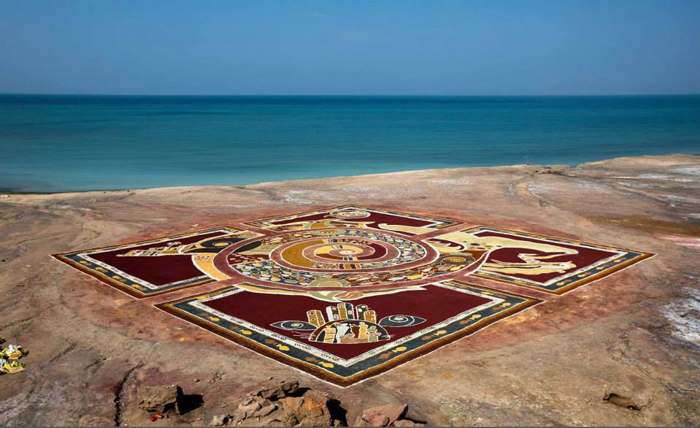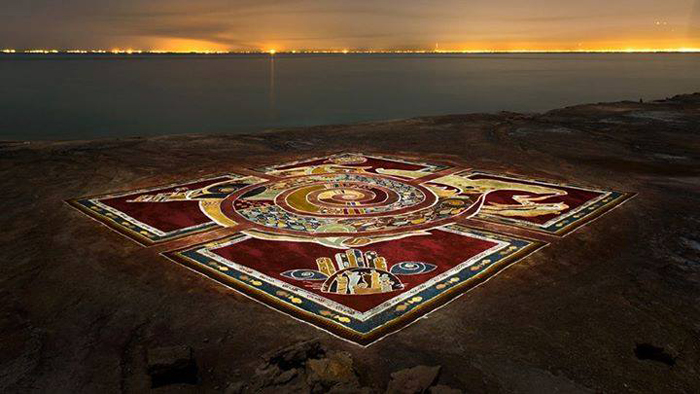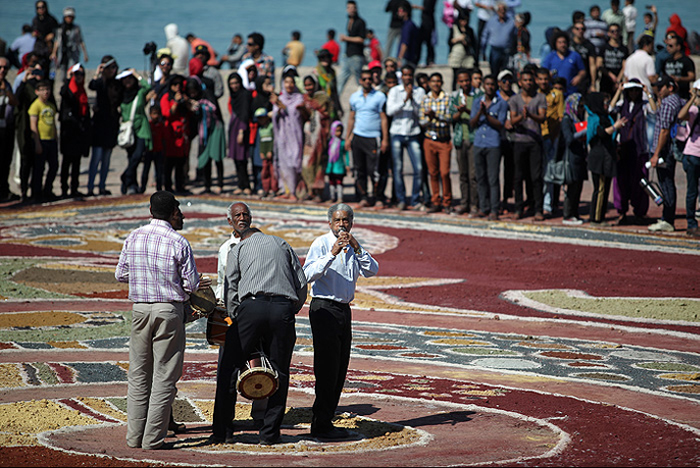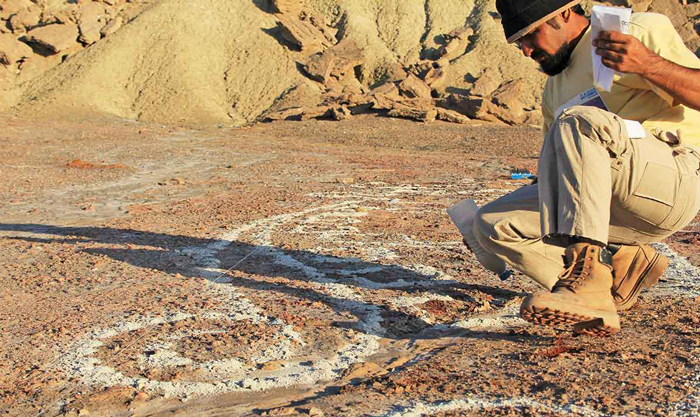![......[ AhmadAli Kargaran ]......](https://www.blogsky.com/images/logo/ak-96x96.jpg)
......[ AhmadAli Kargaran ]......
Artist .environmental art & site spesific installation .Born in Gambroon city. Iran.![......[ AhmadAli Kargaran ]......](https://www.blogsky.com/images/logo/ak-96x96.jpg)
......[ AhmadAli Kargaran ]......
Artist .environmental art & site spesific installation .Born in Gambroon city. Iran.[ Damahi] دامــــــاهی | فـرش خاکـی هرمـز
داماهی
بر
اساس آنچه از افسانه های محلی هرمزگان و فرهنگ شفاهی این مردم به ما رسیده است،
چنین بر میآید که «داماهی» نام ماهی عظیمالجثهای بوده که در هنگامهی گرفتاریها
به یاری مردمان بومی جنوب میشتافته و ما اعضای «گروه هنر نو هرمز» برای توصیف این
موجود اساطیری از چهار روایت که مبتنی بر عناصر چهارگانه (آب، باد، خاک و آتش)
بهره بردهایم که بنمایهی طرح پنجمین فرش خاکی هرمز قرار گرفته است.
According to Hormozgan Local myth and verbal culture of people, it’s assumed that “Damahy" was the name of a giant fish that helped to helpless local people. Now, the members of “Hormoz New Art Group” have used this mythological creature based on the four narratives included four elements (water, wind, soil and fire) that is the main idea for the Designing of the 5th soil carpet of Hormoz.
روایت اول مبتنی بر کهن الگوی
آتش، داستان عشق پسر فقیری به نام عالی به فاطی دختر پادشاه و دلدادگی آن دو به
یکدیگر است که با مخالفت پادشاه همراه و منجر به فرار این دو دلدادهی هرمزگانی از
دست مأموران پادشاه میگردد.
در
این تعقیب و گریز است که «داماهی» به مدد این دو عاشق آمده، آنها را در دل خود
جای میدهد و به جزیرهی هرمز میرساند.
The first narrative is based on the archetype of fire, and it's a love story of a poor boy called Aali and king's daughter called Fati, this love was faced with king's disagreement and made them escape from king Officers. In this chase and escape, Damahi helped them and gave them a place in its belly and took them to Hormoz Island.
روایت دوم مبتنی بر کهن الگوی خاک، داستان فقر ساحل نشینان و ظاهر شدن «داماهی» در کنارهی ساحل است. در این داستان، داماهی مرواریدهایی که از دل دریا جمعآوری کرده را به ساحلنشینان فقیر میبخشد.
The second narrative is based on the archetype of the soil, and it’s a poverty story of low landers and appearance of Damahi at the edge of the beach. Based on this story Damahi donated all the collected pearls deep inside of the sea.
در روایت سوم مبتنی بر کهن الگوی آب، نقل میشود که در هنگام بادِ کوش (Koush) ـ بادی که دریا را متلاطم میکند و با امواجی خروشان همراه است- «داماهی» به کمک ناخدایان و جاشوهایی میآید که لنجشان گرفتار طوفان شده، تا آنها را به سلامت به ساحل امن برساند.
In the third narrative based on the archetype of the water, it’s been said that when Koush wind is blowing (the wind that makes the stormy sea and splashing waves) Damahi helped the captains and seamen that their boats were trapped in a storm to take them to the safe shore.
در روایت چهارم مبتنی بر کهن الگوی باد، نقل می شود که دروازه ی هرموز از جمجمهی «داماهی» ساخته شده بود. جمجمهای آنقدر بزرگ که دهاناش محل ورود و خروج مردمان به جزیرهی رنگها بوده. از حفرهی یک چشم، خورشید طلوع و در حفرهی خالی چشم دیگر، غروب میکرده است.
In the 4th narrative based on the archetype of the wind, it’s been said that Hormoz gate was made of the Damahi skull. The Skull was large enough that its mouth was a gate for people entrance and exit to island of colors. From one eye, the sun was rising and in the other eye, the sun was going down.
همانگونه که اشاره شد برای توصیف این موجود اساطیری از چهار روایت مذکور استفاده و در چهارگوشهی طرح، تصویرسازی شده است تا داستانی بر پایهی اتصال آنها به هم با عنوان «داماهی» شکل گرفته و به واقع، داستانِ طرح پنجمین فرش خاکی هرمز باشد. اسپیرالی با چهار درگاه ورودی به مرکزِ طرح یا همان دل داماهی؛ در این میانه، شهود و شناخت به آرمان شهری می رود که از آن در افسانه های ملل مختلف بارها خوانده و شنیده ایم. اسپیرالی به درون، حال آن که غافل مردمانی عمر خود را بر سر جُستار این اتوپیا وقف کرده، از دریاها و کوهها گذشته و ناکام بازگشته اند.
As
mentioned before, we use each of these four narrative story on the each corner
of the soil carpet design and connected them to form the Damahi that was the
main idea for the 5th soil carpet of Hormoz.
A Spiral with four doorways to the center of design or the Damahi’s belly. In
the meantime, Intuition and knowledge will end to the Utopia that we have read
and heard it many times in legends of different nations. A Spiral to inside,
while unaware people endow their life to finding this Utopia, have passed the
sea and the mountains and have returned Disappointed.
اعتقاد بر این بوده و هست که دل داماهی سرشار از حاصلخیزی و نشاط و شادمانی است. در دل داماهی خبری از کشتار، شکنجه و جنگ نیست و تنها صدای ماندگار، صدای صلح است. طرحِ ما، چهار درگاه به سوی صلح است که با ورود شما به طرح به عنوان مخاطب تمامیت خود را باز مییابد تا فرشِ امسال، سوار بر پیکر داماهی، پهنهی اقیانوسها و دریاها را شکافته، قاره به قاره بگذرد و در شهرهای مختلف دنیا، پیام و سرود صلح مردمان ایران زمین را به تمامی انسانها، فارغ از هرگونه نژاد، مذهب و ملیتی برساند.
There
is a belief that Damahi’s belly is full of fertility and happiness and joy. In
the belly of Damahy, there is no news of killings, torture and war and the only
steady voice is the voice of peace.
Our design is four doorways toward peace that will find its entirety again with
your entry to the design as an audience. With your visit, This carpet, riding
on the Damahi’s body, splits the oceans and seas, passes Continent by Continent
and sends anthem and message of Peace of Iranian people to all human beings,
regardless of any race, religion and nationality in different cities of the
world.
احمد علی کارگران
Ahmad Ali Karagaran






احمد علی کارگران
طراح فرش خاکی هرمز | داماهی | جزیره هرمز | 1392
اجرا : گروه هنر نو هرمز


























